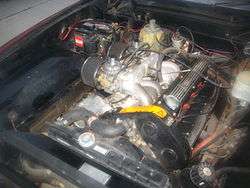Lotus 900 series
Lotus 900 series engines were designed by Lotus as their first self-developed engine, and due to similarities in dimensions and layout, Vauxhall/Opel/GM 4-cylinder iron blocks were used as testbeds for the Lotus DOHC 16 valve cylinder head.[1] All of the production 900 series engines used Lotus' own aluminium block.
The 900 series engine was introduced in production form as the Lotus 907 in the 1972 Jensen-Healey, and went on to power Lotus into the late 1990s. It is regarded as the first modern DOHC, 16-valve production engine made. The Jensen-Healey was released for sale to the general public with the first 907 engine shortly before the Cosworth Vega which also had a DOHC, 16-valve engine. Pre-war DOHC 4 valve per cylinder production engines included the Duesenberg and the Stutz DV-32 straight-8 engines.
904
The initial 2.0 litre Lotus 904 engine was first used in the Lotus type 62 Europa racecar, and indeed used a Vauxhall iron block. The Lotus marketing designation for this engine was LV220 for Lotus/Vauxhall 220 bhp.[2] According to Jeremy Walton this 220 bhp (164 kW; 223 PS) was developed at 8000rpm.[3]
907

The Lotus 907 engine, the first production version, was 2.0 L (1973 cc) and was used in the Jensen-Healey and later Lotus Esprit, Lotus Elite and Lotus Eclat. Bore was 3.75 in (95.28 mm) and stroke was 2.725 in (69.24 mm), and a DOHC 4-valve head was fitted, one of the first in modern times. Breathing through dual carburettors, the engine in final form as used in the Esprit produced 160 bhp (119 kW; 162 PS) at 6500 rpm with 140 lb·ft (190 N·m) of torque. Initial figures for the Jensen-Healey version were 140 bhp (104 kW; 142 PS) and 155 bhp (116 kW; 157 PS) as used in the first Elite cars.[4]
Applications:
- 1972-1976 Jensen-Healey
- 1975-1976 Jensen GT
- 1974-1980 Lotus Elite S1
- 1975-1985 Lotus Eclat S1
- 1975-1978 Lotus Esprit S1
- 1978-1981 Lotus Esprit S2
911
The engine was modified in 1978 into the 2.2L type 911, which was fully designed by Lotus, used in the winning Lotus Talbot Sunbeam rally and production cars. In road trim the Lotus type 911 engine produced 150 bhp (112 kW; 152 PS) at 5,750rpm and 150 lb·ft (203 N·m) of torque at 4,500rpm.[5] In rallying trim this was increased to 250 bhp (186 kW; 253 PS).[6]
Applications:
- 1979 - 1981 Sunbeam Lotus
912
Also known as the naturally aspirated "Lotus 910", the stroke was increased to 76.2 mm giving a displacement of 2.2 L (2174 cc). As used in the 1980s Lotus production cars this engine was rated at 160 bhp (119 kW; 162 PS) at 6,500rpm and 160 lb·ft (217 N·m) of torque at 5,000rpm.[7] For 1986-on Lotus Excel SE and automatic Lotus Excel SA this rating was raised to 180 lb·ft (244 N·m).[8]
Applications:
- 1981 Lotus Esprit S2.2
- 1981-1990 Lotus Esprit S3 and NA
- 1981 Lotus Eclat S2.2
- 1982 Lotus Excel
- 1986 Lotus Excel SE and SA
910
Turbocharged engines introduced in 1980 were known as the type 910, which in high compression configuration produced 215 hp (160 kW) and an 220 lb·ft (300 N·m) of torque. For markets with stringent emissions requirements, Lotus introduced Bosch KE-Jetronic fuel injection - the first fuel-injected Esprits. This Bosch fuel injection was used in 1986, 1987, and 1988 model years. In 1989 The Bosch fuel injection system was superseded by Delco GMP4 electronic fuel injection. Included in this change to Delco engine management is the addition of crank-fired wasted spark ignition that removed the need for a distributor. The engine was again upgraded in 1990 to the type 910s for use in the Esprit SE where it produced 280 horsepower (210 kW) with the addition of a water to air intercooler known as the Chargecooler. In its ultimate incarnation as used in the Sport 300, X180R and S4s the engine was capable of 300 horsepower (220 kW), propelling these cars to 0-60 times in the low 4 seconds.
Applications:
- 1980-1990 Lotus Esprit Turbo
- 1990-1993 Lotus Esprit SE
- 1993 Lotus Esprit Sport 300 and X180R
- 1993-1996 Lotus Esprit S4
- 1995-1996 Lotus Esprit S4s
920
The 920 is a 2.0 litre configuration, originally only available in the Italian market where the lower engine displacement meant the vehicle would fall into a lower tax regime. The 920 was again utilized from 1996 to 1999 in the Esprit GT3 models, utilizing the improvements that served the SE models making these cars good for 240 hp (180 kW). This was the last application of the 900 series Lotus engine, which had a lifespan of nearly 30 years. However, unlike the 907 and its derivations, this engine was of a more square design, 84.45 x 89 mm, making for an overall displacement of 1,994 cc.
Displacement:
1973 cm3 / 120.2 cui
Bore:
95.3 mm / 3.75 in
Stroke:
69.2 mm / 2.72 in
918
A 3.5 liter V8 derivative of the 900 series dual overhead cam inline 4, the 918 saw its only production car application in the Lotus Esprit V8.
Notes
- ↑ Adcock, Ian. Lotus Heritage. Osprey Automotive, 1995, p. 38.
- ↑ Adcock, Ian. Lotus Heritage. Osprey Automotive, 1995, p. 39.
- ↑ Walton, Jeremy. Lotus Esprit, The Complete Story. Crowood AutoClassics, 1997, p. 22-25.
- ↑ Adcock, Ian. Lotus Heritage. Osprey Automotive, 1995, p. 39-40.
- ↑ Adcock, Ian. Lotus Heritage. Osprey Automotive, 1995, p. 42.
- ↑ Adcock, Ian. Lotus Heritage. Osprey Automotive, 1995, p. 42.
- ↑ Adcock, Ian. Lotus Heritage. Osprey Automotive, 1995, p. 42.
- ↑ Walton, Jeremy. Lotus Esprit, The Complete Story. Crowood AutoClassics, 1997, p. 23.
References
Adcock, Ian. Lotus Heritage. Osprey Automotive, 1995 ISBN 978-1-85532-508-1
Walton, Jeremy. Lotus Esprit, The Complete Story. Crowood AutoClassics, 1997 ISBN 978-1-86126-066-6